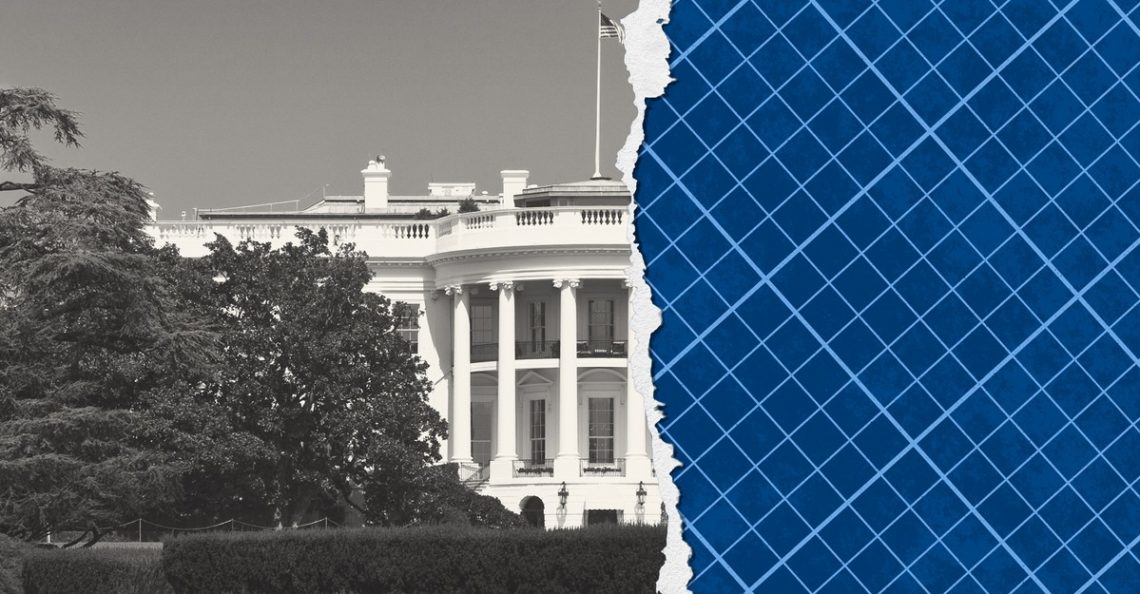When Donald Trump abruptly demolished the White House’s East Wing last month, he shattered a culture of consultation with experts that has shaped Washington’s architecture for 125 years—since the last time an administration tried to massively enlarge the White House.
Over three cold days in December 1900, members and guests of the American Institute of Architects gathered at the capital’s Arlington Hotel and strategized about how to stop a White House expansion that they deemed an affront to a treasured American icon. Under President William McKinley, the government official who oversaw public buildings in the District of Columbia had proposed to add two huge, ornate wings directly to the sides of the White House. These, the architects believed, would overwhelm the existing building and disfigure its classical simplicity.
The group wasn’t trying only to stop the renovation. It was also trying to elevate the influence of professional expertise over the appearance of major urban landmarks in the nation’s capital and across the country. Led by the architect and historian Glenn Brown, group members wanted to show that their specialized knowledge would produce more livable cities than would the hasty or imperious schemes cooked up by politicians and their friends.
One of the politicians they most impressed was Theodore Roosevelt, who ascended to the presidency after McKinley’s assassination the following year. Roosevelt and his wife, Edith, listened to Brown and his allies. The Roosevelts hired the respected architecture firm McKim, Mead & White, which renovated the White House in a way that respected the design of James Hoban, the original architect. The firm’s key innovation was to add two low-slung annexes—the West Wing, for the president’s staff, and the East Wing, for entertaining—that nestled behind trees a generous distance from the mansion. To use modern phrasing, the architects had used design thinking to redesign the problem itself.
McKim, Mead & White’s creative solution set an informal norm—an understanding between political authorities and outside experts—that subsequent presidents mostly followed. When Franklin D. Roosevelt expanded both wings to match the expanding offices of the president and first lady, he directed his architects to keep the new roofs low, sacrificing the quality of interior spaces out of deference to history. In 1961, First Lady Jacqueline Kennedy led a drive for federal legislation that declared the building a museum, and she established the White House Historical Association to help maintain the structure’s historic look and feel.
In contrast, Trump’s ballroom utterly abandons the precedent established in 1900. The square footage of the new space dwarfs the original mansion, while its parapet appears to be the same height as that structure, thrusting out from the tree cover that hid the old East Wing.
In the past couple of weeks, many commentators have argued that Trump had no right to demolish the East Wing, because the White House belongs to the American people and not to the president. I agree with the sentiment. But that isn’t the law. The principle of deference to Hoban’s original mansion was never made legally binding on the president. A system in which power is constrained primarily by norms is easy to change. Trump and his staff clearly recognize this and have moved to take advantage—not just in renovating the White House but in matters of health, science, and countless other areas of government policy.
After the architects’ convention in 1900, public officials turned to specialists to address questions of aesthetic and space planning that had previously been matters of politics and patronage. Over the decade that followed, most public-building projects in D.C. came under a system of formal design review. The Senate commissioned a visionary proposal, which came to be known as the McMillan Plan of 1902, to reinvent the city and its parks. In 1910, Congress created a Commission of Fine Arts to guide the design of federal buildings in Washington. Its powers were strictly advisory. Compliance was at the discretion of the president, who also hired and fired the commission’s members. And when Congress passed the National Historic Preservation Act of 1966, it exempted the White House, the Capitol Complex, and the Supreme Court Building from a federal historic-preservation process that is itself less binding than anything a homeowner in a historic district might face. Power didn’t like to be constrained, even before Trump came along.
The strongest authority that could still weigh in on the demolition and the proposed ballroom is the National Capital Planning Commission. The NCPC’s establishment in the 1920s followed a populist campaign by the organizer Harlean James, who drove around the country with her mother and organized clubs to lobby for stronger planning in Washington. Her pitch was that the capital belonged to all Americans. She convinced thousands of Americans that it should be a model for the nation and that its development was so important it could be handled only by the top experts in planning and design.
But Trump appointees now dominate the NCPC. His representatives lack relevant expertise and have shown little interest in the deliberative procedures that have been standard for a century. This week, the president fired the entire Commission on Fine Arts and did not immediately announce new appointees. Meanwhile, the federal government’s historic-preservation workforce has been decimated by DOGE. Its meticulous design processes for federal buildings appear endangered by a loosely written executive order that, in the name of conveying “dignity,” calls for using classical architecture. Renderings of Trump’s proposed ballroom show an ostentatious version of that style.
Up to now, federal architecture has reflected a balance between executive-branch discretion and the influence of trusted experts. Trump has shown how fragile that approach was all along—and how both professionals and ordinary Americans took it for granted.
The institutional damage from the destruction of the East Wing is far greater than the loss of historic fabric. Trump is pushing other grandiose projects, such as an arch at Arlington Memorial Bridge and a Garden of American Heroes. If those projects go through, and if new federal buildings are designed according to his personal taste, he will reshape Washington much as the illiberal leaders Viktor Orbán and Recep Tayyip Erdoğan have reshaped the capitals of Hungary and Turkey.
Perhaps a new Harlean James or Glenn Brown will come along and rally public opinion against leaving D.C. to the president’s whims. For now, though, Trump has created a void. The culture of expert guidance created back in 1900 became rubble with the roof of the East Wing.
The post White House Architecture Was an Honor System. Trump Noticed. appeared first on The Atlantic.




